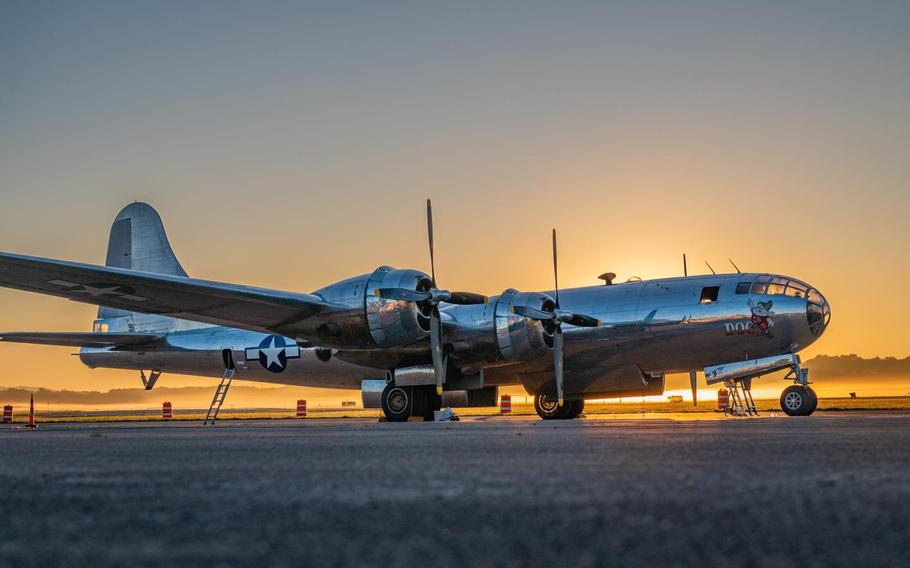
Dozens of people at Lehigh Valley International Airport had a chance to see the massive B-29 air bomber christened “Doc.” The B-29, which was unveiled in 1944, helped lead America to victory in World War II. (B-29 Doc/Facebook)
(Tribune News Service) — Sandy James’ father flew B-29s not long after they were delivered for the World War II effort.
He also flew them during the Korean War — all told at least 20 missions, she said.
On Thursday, the Macungie resident joined dozens of people at Lehigh Valley International Airport to see the massive air bomber. The planes, which were unveiled in 1944, helped lead America to victory in World War II.
After touring the front, where replicas of bombs hung over a cramped compartment near the cockpit, James was filled with emotion. She recalled how her late father, H. Edwin Godshall, built and flew model planes with her. But he never discussed his time flying B-29s for the military.
“It’s hard to believe,” she said about how up to a dozen service members rode in tight quarters for thousands of miles on military missions to defend America. “He loved it, but I understand why he didn’t talk about it.”
Christened “Doc,” with a caricature of the “Snow White” dwarf on its nose, the B-29 is parked this weekend at Lehigh Valley International Airport. Volunteers with the nonprofit Doc’s Friends Inc. manage the plane and have been taking it on tours nationwide since 2017, a year after it was completely refurbished.
About half the year is spent showing off the two-story, 100-foot-long aircraft, which weighs about 80,000 pounds and has a nearly 150-foot wingspan. The rest of the year is spent maintaining the aircraft at its home base in Wichita, Kan., organizers said.
Josh Wells, the Doc’s Friends spokesperson, said the group expects to visit nearly three dozen cities across 14 states this year, giving tours and rides to people who are interested in paying $10 to walk on the grounds, and up to $1,500 for a ride in bombardier seating.
It costs about $15,000 per hour of flight to operate the aircraft, Wells said, with the money generated by the tours, rides and memorabilia sales supporting the nonprofit.
LVIA spokesperson Colin Riccobon said the airport authority was contacted by Doc’s Friends about bringing in the B-29.
“We were certainly excited about the chance to bring a historical part of the aviation industry to the region,” he said.
The B-29 Doc — Wells said the plane was part of a squadron named for Snow White and the Seven Dwarfs — came to Wichita in pieces on the back of semis in 2000 before it underwent restoration. It was one of 1,644 so-called “Superfortresses” Boeing made in Wichita during World War II and is one of two remaining that can still fly.
The yearslong restoration was almost as massive a project as what it took to build and fly the planes late in World War II.
The B-29 was designed for high-altitude strategic bombing, also excelling in low-altitude night incendiary bombing and in dropping naval mines to blockade Japan. But the craft’s main legacy was dropping atomic bombs on Hiroshima and Nagasaki in August 1945, which led to the Japanese surrender and end of the war.
Wells and others said showcasing the plane is a way to show America’s technological ingenuity and hard work by those considered part of the country’s “greatest generation.”
“We want people to get up close, see it, touch it, crawl up inside it,” Wells said. “We’re hopeful that we’ll inspire the next generation of airline workers, aviation workers, people who are involved in technology, aerospace and beyond.”
Matt Sayenga of Bethlehem, who enjoyed seeing the cockpit, said concerns about America’s power at war should be offset by the effort undertaken to defeat an enemy that provoked the country into battle.
“When I look at it, I don’t actually see a weapon of war,” Sayenga said. “I see the technology, the ingenuity, the engineering, like when you look at a bridge. It’s like, wow, we built this.”
Chief pilot Mark Novak, a retired Air Force veteran among the volunteer B-29 fliers, said the plane can travel about 3,000 miles without refueling.
He said it “sort of wobbles” and “acts squirrely” but is impressive to fly.
“It’s like a pickup truck on a gravel road,” Novak said.
The plane, which landed Monday at LVIA, can be seen through Sunday. Ground and cockpit tours will be held Friday through Sunday from Hangar 10, off Postal Road in Hanover Township, Lehigh County. The B-29 will go on four sold-out flights, 9 and 11 a.m. Saturday and Sunday. For hours, pricing and more information, go to b29doc.com/events.
©2024 The Morning Call.
Visit mcall.com.
Distributed by Tribune Content Agency, LLC.